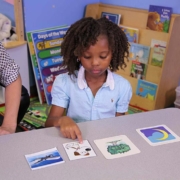How Expanding Language Through Play Helps with ASD
Expanding language through play helps children who may experience delayed or absent speech as one of the core symptoms of autism spectrum disorder (ASD). While some children experience delays in reaching language milestones, others may benefit most from alternative forms of communication, such as sign language or communication via devices.
When language skills do not allow a child on the autism spectrum to effectively communicate their wants and needs, we often see problem behaviors emerge. For this reason, it is crucial to show a child the value of language through reinforcement.
Why is expanding language through play so important?
When you reinforce communication, you are creating a consequence that will make communication more likely to happen again in the future. In other words, your child will learn that good things follow when they use language. For example, when your child repeats the sound “buh” after you give them a model, you can reinforce their behavior by blowing bubbles. The next time your child sees a jar of bubbles, they will be more likely to attempt to communicate using “buh.”
Reinforcement is very child-specific, so you want to select activities or items that you know your child really enjoys.
How do I choose language goals?
Begin by selecting the mode of communication you will teach a child on the spectrum to use. It is best to start with the mode they have already demonstrated using. For example, if they communicate often using sign language, start with signing goals.
Choose the lowest effort responses in the beginning. If they communicate using one-word vocal requests do not expect two-word vocal requests in the beginning. It is important that a child on the autism spectrum contacts with success very frequently in the beginning because we want them to see that language is the best way to communicate their needs.
Once the child is reliably communicating completely independently, then you can move on to a more challenging goal.
How do I set up learning opportunities for expanding language through play?
- Follow their interests: Observe your child during their playtimes. See which kinds of toys they gravitate toward. If something catches their eye, let them check it out!
- Parallel play: When you are ready to teach, begin parallel play with your child. Do not require sharing yet, just get the child used to you playing next to them. Join in the fun by narrating what they are doing and making sound effects! Again, if their interest shifts to something else, go along with their choice.
- Set up motivation: Your child will not ask for something they’ve already got, so look for an opportunity to briefly withhold access to an item. This could mean giving them a play-doh toy while you have the play-doh. If your child is coloring, hand them the coloring book but not the markers. Try setting something on a shelf out of reach so they need to ask you for help.
- Reinforce!: Begin simply with a response you know your child can do. If they communicate with gestures, guide them to point to what they want and then immediately give them access to what it is they want. Reinforcement should be immediate, paired with praise, and not given until
- Expand gradually: Try getting the simplest response from the child first. For example, if a child can already communicate using multiple-syllable words, start with one-word requests (e.g. “play-doh”). Once they show you that they can do this independently, move to multiple-word responses (e.g. “want play-doh” and then “I want play-doh.”)
Remember: Expanding language through play should look and feel like play! If you start to notice that your child is pulling away from you when you join in playtime, go back to parallel play and pair yourself with all things fun. This shouldn’t feel like work time.
What are some things I can teach?
- Echoics: Try to get your child to imitate the noises you are making. These could be single sounds, words, sentences, or even sound effects!
- Requests: Have your child ask for items they may want. They can ask by pointing, signing with ASL, using a communication device, handing you a picture, or using their words.
- Labeling: Ask your child to label things like colors, letters, animals, or characters. If you can hear a siren in the distance, ask your child “what is that?” to work on labeling sounds.
- Fill-in-the-blank/answering questions: Narrate what you are doing and try to get your child to answer your question. Examples of questions to ask your child are “what does a cow say?” or “Which is your favorite?” Some fun fill-in-the-blank statements are “ready, set ___(go!)” or “3, 2, 1, ____ (blast off!).” You can also use song lyrics for more fill-in-the-blanks.
- Asking questions: Teach your child to ask questions about their environment, such as “where’s the ____?” or “how do I ____?” if they need some help.
What do I do if problem behaviors occur?
Problem behaviors with children on the autism spectrum, such as tantrums or aggression, may result from withholding access to toys or other items. This is expected when you are asking the child to try something new or difficult. Our goal is to show the child that language is the fastest and clearest way to communicate, not problem behaviors.
Offering an item while a child is in behavior should be avoided because this can reinforce the problem behavior rather than language. Instead, wait until they are calm and try again.
It is very important that you seek assistance from a Board Certified Behavior Analyst (BCBA) to address any serious behavioral concerns. Your BCBA will work with you to develop strategies to address any reoccurring problem behaviors your child may be exhibiting. If you do not ask for assistance, you may unintentionally reinforce problem behaviors or end up in an unsafe situation for you or your child.
Where can I learn more?
If you would like to receive training in expanding language through play, please contact a BCBA. Check out this video to see an example of a teaching session!

JULIA McCARTER
Title: BCBA
Julia McCarter is a Board Certified Behavior Analyst (BCBA) and a Licensed Behavior Analyst (LBA) with Behavior TLC and Grand Oak Academy. Julia grew up in Iowa and later moved to Texas, where she received a Bachelor of Arts in psychology from Trinity University.
She attended the University of Houston-Clear Lake for graduate school and received a Master of Arts in behavior analysis. Julia has spent several years working as a behavior analyst in Houston area ABA clinics and joined the BTLC team in July of 2018.











